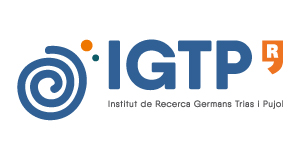CMCiB: Preclinical studies: Biocontainment levels 1, 2 or 3, medical imaging and surgery
GINYS-IGTP-010
The Center for Comparative Medicine and Bioimaging (CMCiB) has been designed and equipped for a wide range of biomedical research and technological development and maintains strict standards of sustainability and research within the 3R policy.
The CMCiB is a unique combination of public infrastructure and business partners. It offers opportunities for advanced biomedical research, surgery innovation and technological development, with the support of expert consulting services and state-of-the-art teaching programs for healthcare professionals and researchers from around the world.
The center is equipped with the latest surgical diagnostic imaging facilities, including experimental technologies under development; this is possible thanks to collaborations with collaborating companies. The expressly built facilities include conventional, biocontainment and barrier environments for rodents. Each area is designed with integrated laboratories and specialized areas to maximize animal welfare and reduce the need for movement and transportation of subjects and materials. At all times the CMCiB is dedicated to applying the principle of 3Rs and to encouraging the use of alternative methods for preclinical research.
Our professionals will advise on the use of alternative methods for preclinical research made available through collaborations.
- Zebra fish
- Drosophila melanogaster
- Computational models
- Bioimage
Services
- Biocontainment
The infrastructure is equipped for the biocontainment of animal models and includes conventional, immunosuppressed and level 3 biosafety housing. The service areas have been designed with sterilization equipment built into the entry points so that maintenance can be carried out without entering the work areas. This integrated organizational design means that the system is aimed at carrying out research activities and services simultaneously and independently, with home automation systems in place to control conditions and processes.
- Surgery training
There is ample operating space available for large animals, tissue, cadavers and simulators and it can be configured as needed. Four modular experimental theaters can offer up to 8 workstations. They are equipped with integrated minimally invasive surgical and imaging technologies.
-
Medical Device validation, GLP code BPL059CAT
- Operating theatres and laboratories
The laboratories are integrated with the different areas of biocontainment. Each is designed to provide maximum security and optimize workflow.
- Bioimage
A distinctive feature of the CMCiB is the level of technology available in general and in the field of diagnostic imaging in particular. In order to comply with 3R policies and meet the goals of reducing the number of subjects used in each process, a number of imaging techniques are essential to the work of the center. Currently available equipment includes:3 Tesla MRI, a laboratory of vascular interventional radiology, surgical arm C, ultrasound, 3D laparoscopy and endoscopy for large animal models and MicroCT, in vivo luminescence and fluorescence imaging systems for small animal models or tissues.
The Ethics Committee for Animal Experimentation CEEA
All work at the CMCiB must comply with current Spanish and European legislation governing ethical research and animal welfare. The facility is registered as B9900009 at Generalitat de Catalunya. On July 2018 the Ethics Committee for Animal Experimentation (CEEA) of the Center for Comparative Medicine and Bioimaging of Catalonia (CEEA-CMCiB) of the IGTP was set up to ensure rapid and transparent approval. of the proposed experiments in accordance with international standards and an effective monitoring body.
Functions:
- Verification and approval of all research project proposals ensuring that the adequacy of the procedure in relation to the objectives of the study, the relevant conclusions can be reached with the smallest number of animals and that the effect on animals does not it is disproportionate in relation to the potential benefits of research
- To act as an intermediary between the Generalitat de Catalunya and the researchers who will carry out the research
- Quantify and report on the operation of the center in matters of animal welfare, veterinary reports, periodic checks carried out by the commission and acting on the basis of comments received from users of the center.
- Report of the state of the facilities of the center for the lodging and the search of animals and review of reports for the Direction of the institute (IGTP)
Equipment
Efficiency and sustainability
The CMCiB offers 4,500 m 2 organized in specialized spaces designed for its different activities. The facility has been built for maximum sustainability and minimal impact on the surrounding natural park, which means it is integrated into the slope and has a low carbon footprint. Services include the latest technology to save energy and heat and, despite being underground, make the most of natural light and heat; it also incorporates a greywater management system. Most processes are automated, with the latest home automation technology and security systems.
Specifically built facilities include conventional, biocontainment and barrier environments. Each area is designed with integrated laboratories and specialized areas to minimize animal movement and maximize welfare.
Equipment
- Lead-lined operating room with surgical C-arm, equipped with endoscope. Audiovisual links integrated in the audiovisual training room (or outside)
- Three modular operating rooms with minimally invasive 3D technology. Audiovisual links integrated in the audiovisual training room (or outside)
- 3 Tesla MRI
- Vascular interventional radiology operating room
- Ultrasound
- SPF barrier laboratory space, cell culture and operating rooms
- SPF barrier Drosophila laboratory space
- SPF barrier laboratory, operating room with cesium radiator
- Accommodation for small and large animals
- Accommodation area for aquatic animals
- Conventional laboratory space and operating rooms
- Luminescence and fluorescence bioimaging installations
- Micro CT
- Meeting rooms
Audiovisuals
- Training and conference room with capacity for 40 people
- Audiovisual system integrated in operating rooms with videoconference in the hospital (larger capacity rooms)
- Recording facilities and private streaming systems
Research and training services
- Personalized training and support for experimental surgical models
- Advice on design and execution of research projects
- 3R research models
- Application of experimental procedures
- Management of accreditations and authorizations
- Anesthesia and analgesia
- Animal welfare
- Technical staff
- Ethics Committee




